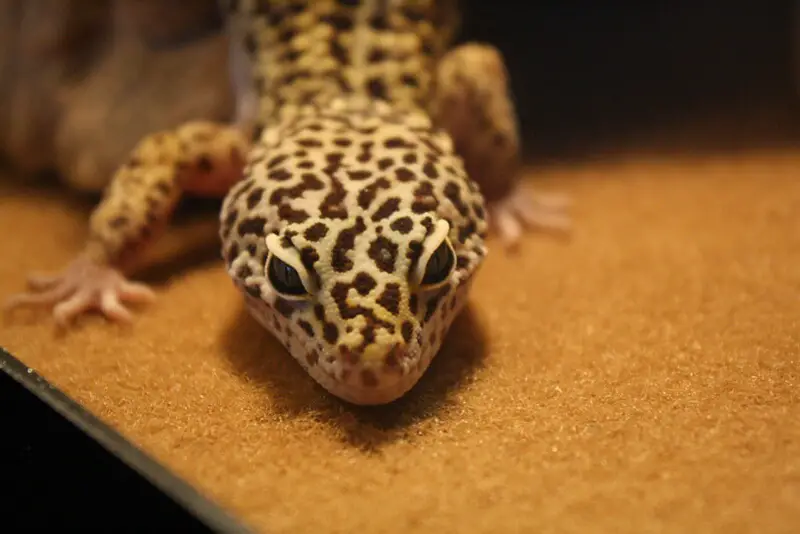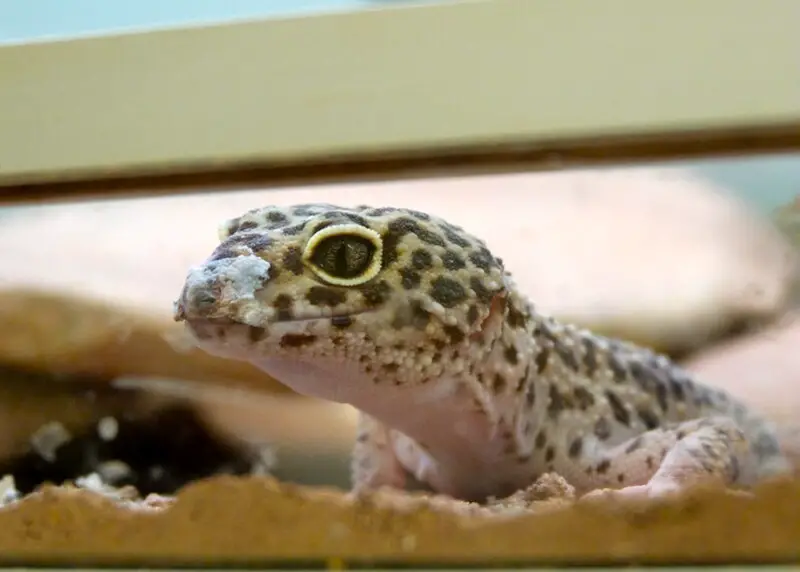Leopard geckos are fascinating creatures, known for their unique behaviors and characteristics. One common and intriguing behavior that many leopard gecko owners have observed is digging. If you’ve ever wondered why your leopard gecko digs, this comprehensive guide will provide you with an in-depth understanding of this behavior and its various aspects.

The Natural Habitat of Leopard Geckos
To comprehend why leopard geckos dig, it’s essential to delve into their natural habitat. Leopard geckos originate from arid regions of South Asia, particularly Afghanistan, Pakistan, and parts of India. In these habitats, they have adapted to a life in rocky deserts and semi-arid environments.
- Arid Environment: The natural habitat of leopard geckos is characterized by low rainfall, extreme temperatures, and a scarcity of vegetation. The terrain is rocky and often devoid of dense foliage.
- Burrowing Species: Leopard geckos are ground-dwelling and are considered burrowing or fossorial reptiles. They are well-adapted to a life spent partly underground, using burrows as a means of thermoregulation, protection, and shelter.
- Temperature Fluctuations: The desert environment they come from experiences significant temperature fluctuations between day and night. Leopard geckos have evolved mechanisms to cope with these extremes, and their burrows help them maintain a stable temperature.
- Predator Avoidance: Leopard geckos dig burrows to avoid predators and harsh environmental conditions. Their burrows offer safety and a refuge from extreme heat or cold.
Given their natural history and the environment in which they evolved, the behavior of digging is deeply ingrained in the behavior and instincts of leopard geckos. In captivity, these instincts can still manifest, often leading to digging behaviors that may appear puzzling to their human caretakers.
Reasons Why Leopard Geckos Dig
Leopard geckos dig for several reasons, reflecting both their natural instincts and specific needs in captivity. Understanding these reasons can help you provide the best care for your pet and ensure that their digging behavior is appropriately addressed.
1. Thermoregulation
One of the primary reasons leopard geckos dig is to regulate their body temperature. In their natural habitat, they utilize their burrows to escape the scorching heat of the desert during the day and to stay warm during the cooler nights. In captivity, they may dig to achieve similar temperature regulation:
- Cooling Down: If the ambient temperature in their enclosure becomes too hot, leopard geckos may dig to reach cooler, subterranean areas. This behavior helps them escape heat stress and avoid overheating.
- Warming Up: Conversely, when they feel cold or during the cooler nighttime hours, leopard geckos may dig to find a warmer spot within their enclosure. This allows them to maintain their ideal body temperature for digestion and other metabolic processes.
To facilitate proper thermoregulation, ensure that your leopard gecko’s enclosure provides a temperature gradient, with a warm basking area and a cooler zone. The choice of substrate and the placement of heating elements play a crucial role in creating this gradient.
2. Hide and Shelter
In their natural habitat, leopard geckos use burrows as hiding spots and shelter from predators and harsh environmental conditions. These instincts persist in captivity, and your gecko may dig to create a secure refuge:
- Privacy: Leopard geckos often seek privacy when they feel stressed or when they are about to shed their skin. They may dig to find a quiet and concealed space where they can remain undisturbed.
- Protection: The burrows provide protection not only from potential threats but also from bright lighting or disturbances. A dug-in hiding spot allows them to feel safe.
- Egg Laying: Female leopard geckos may dig to create a nesting site when they are ready to lay eggs. This behavior is especially relevant if you have a female gecko.
To cater to these shelter-seeking tendencies, provide ample hiding spots in the enclosure. Half logs, cork bark, and reptile caves are suitable choices. Ensure these hiding spots are located in both the warm and cool areas of the enclosure to accommodate their preferences.
3. Foraging and Exploration
Leopard geckos are inquisitive creatures and may dig as a means of exploration and foraging:
- Hunting Behavior: In the wild, they dig to uncover prey, such as insects and small invertebrates, hidden beneath the sand or soil.
- Exploration: Leopard geckos are curious by nature, and they may dig as a way to explore their surroundings and discover new areas of their enclosure.
In captivity, you can encourage this natural behavior by providing enriching opportunities. For example, burying feeder insects in a shallow dish filled with substrate can mimic the sensation of foraging in the wild. Just ensure that the substrate used for this purpose is clean and free from impaction risks.
4. Nesting and Egg-Laying
If you keep both male and female leopard geckos together, or if you have a female gecko, digging may be related to nesting and egg-laying behavior. Female leopard geckos dig burrows to create nesting sites for their eggs:
- Preparation: Before laying eggs, female leopard geckos often dig a burrow in which they deposit their eggs. This digging behavior is a sign that they are preparing to lay eggs.
- Egg Placement: Once the burrow is complete, the female will lay her eggs within it. The eggs are typically placed in a shallow depression in the substrate.
- Protection: The burrow provides a safe and concealed environment for the eggs, helping to protect them from predators and environmental factors.
If you observe digging behavior in a female leopard gecko, it’s essential to provide a suitable egg-laying box, often referred to as a lay box. This is a container filled with moist substrate (such as vermiculite or perlite) that allows the female to lay her eggs safely. Providing a lay box ensures the eggs remain viable and prevents the female from becoming egg-bound, a potentially life-threatening condition.
5. Environmental Enrichment
Leopard geckos benefit from mental and physical stimulation, and digging can be an enriching and engaging activity for them:
- Stimulation: Encouraging natural behaviors like digging can help keep your gecko mentally stimulated and prevent boredom.
- Exercise: Digging provides physical activity, which can be beneficial for leopard geckos’ overall health and muscle tone.
- Preventing Obesity: Providing opportunities for digging and exploration can help prevent obesity, which can be a concern for captive leopard geckos that have limited space to roam.
To offer enrichment, you can create a digging area in your gecko’s enclosure with suitable substrate. Make sure the substrate is clean and free from any potential hazards like impaction risks. Leopard geckos often enjoy loose substrates like play sand or a mix of organic topsoil and sand.

Safe Substrates for Digging
When providing an area for your leopard gecko to dig, it’s important to select a safe substrate. The right substrate not only encourages natural behavior but also minimizes potential risks, such as impaction. Here are some substrate options suitable for leopard gecko digging areas:
- Reptile-Safe Sand: Play sand or reptile sand specifically designed for leopard geckos is often used. Ensure that it’s clean and free from contaminants.
- Organic Topsoil: A mix of organic topsoil and sand can provide a suitable substrate for digging. Ensure the topsoil is chemical-free and without additives.
- Coco Coir: This coconut coir substrate is natural and retains moisture well. It’s a good choice for burrowing behavior.
- Vermiculite or Perlite: These materials can be used for nesting boxes and egg-laying substrates.
When using substrates, ensure that they are regularly cleaned and maintained to prevent the buildup of waste and bacteria.
Potential Risks and Precautions
While digging is a natural and healthy behavior for leopard geckos, it’s crucial to be aware of potential risks and take appropriate precautions:
- Impaction Risk: Leopard geckos may accidentally ingest substrate while digging, which can lead to impaction. To reduce this risk, use clean substrates, monitor your gecko’s behavior, and feed them in a separate, clean container.
- Temperature and Humidity: Ensure that the temperature and humidity levels in the enclosure remain appropriate. Inadequate temperature gradients can lead to constant digging as a means of thermoregulation.
- Health Issues: If your leopard gecko’s digging behavior is excessive, prolonged, or appears compulsive, it may be a sign of stress or an underlying health issue. Consult with a veterinarian experienced in reptile care if you have concerns.
- Substrate Hygiene: Regularly clean and replace the digging substrate to prevent the accumulation of waste and bacteria.
- Egg-Laying Needs: If you have female leopard geckos, be prepared for potential egg-laying and provide a suitable lay box to ensure the safety of the eggs and the female.
- Observation: Regularly observe your leopard gecko’s behavior to ensure that digging does not become problematic or excessive.
Conclusion
Leopard geckos dig for a variety of reasons deeply rooted in their natural instincts and behaviors. It’s essential to appreciate and respect this aspect of their nature and provide them with an environment that accommodates their burrowing tendencies. By understanding the motivations behind their digging behavior and taking appropriate precautions, you can ensure that your leopard gecko enjoys a happy and enriched life in captivity. Providing suitable substrates, hiding spots, and nesting opportunities will help you foster a healthy and contented leopard gecko that exhibits its natural behaviors while remaining safe and free from potential risks.
